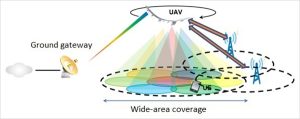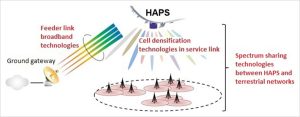Japan’s National Institute of Information and Communications Technology (NICT) has selected two SoftBank research proposals in an open call for newly commissioned research for fiscal 2023. The research is conducted as part of NICT’s Beyond 5G R&D Promotion Project (Efficient Use of Radiowaves), and Innovative ICT Fund Projects for Beyond 5G/6G projects.
SoftBank signed contracts with NICT for the following two research project proposals and commenced R&D activities in October 2023:
- R&D on Network Area Coverage for Emergencies Using High-speed UAVs
- R&D on Technologies for HAPS Mobile Broadband Communications.
To prepare for commercialization, SoftBank is conducting R&D activities on 5G and batteries for High Altitude Platform Station (HAPS) stratospheric-based wireless communication systems, as well as international standardization activities related to HAPS radiowave propagation. HAPS is a technology that can provide stable connectivity from the stratosphere during emergencies and in under-served locations such as mountainous areas, remote islands and developing countries. The two research proposals selected by NICT are both related to R&D for HAPS.
The first research project, R&D on Network Area Coverage for Emergencies Using High-speed UAVs will study the adjustment of radiowave interference that is necessary to provide a stable wireless communication network from the sky. To provide a stable network from the sky and ensure communication continuity during emergencies, for example, it is necessary to adjust radiowave interference between terrestrial base stations using the same frequency bands as sky-based communications, which takes a significant amount of time. In this research project, SoftBank will lead the world in developing and demonstrating technologies that eliminate the need for radiowave interference adjustments (Figure 1).

In the other research project, R&D on Technologies for HAPS Mobile Broadband Communications, SoftBank will work to achieve high data rate and capacity communications for HAPS. In addition to expanding the capacity of communication payloads carried by unmanned aircraft, improving the efficiency of spectrum utilization is crucial to achieve this. SoftBank will study cell density enhancement technologies for “service links,” which handle data transmission and reception between HAPS and communication devices on the ground. SoftBank will also research high data rate and capacity technologies for “feeder links,” which connect communication equipment on HAPS and ground-based network equipment (Figure 2). Utilizing these technologies, SoftBank will aim to double HAPS communication capacity compared to existing methods. Additionally, through spectrum sharing between HAPS and terrestrial networks, SoftBank will aim to realize flexible network area deployment and improve spectrum utilization efficiency by at least 1.5 times compared to existing methods.
Through these R&D projects, SoftBank will aim to provide stable communication networks to under-served locations and regions, and secure network coverage during times of emergencies.

(Image: SoftBank HAPS)
For more information visit:




